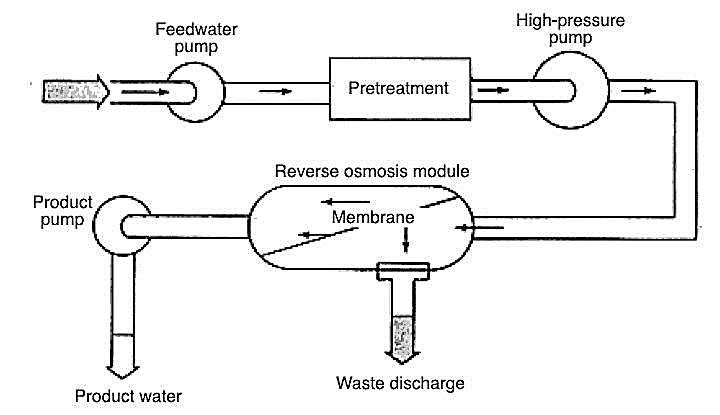
Seawater Desalination with Reverse Osmosis Plant
All Reverse Osmosis plants are basically Desalination Crops but desalination is currently being referred to sea h2o Usually.As sea drinking water has very significant TDS demands really superior pressure to pressure sea drinking water through membranes which can be various then brackish h2o membranes.
Reverse Osmosis Plant Specifics:
A reverse osmosis plant is usually a production plant, where water is purified and desalinated by forcing h2o by way of a membrane, ordinarily known as a reverse osmosis course of action. H2o produced by plant RO might be used for several purposes like desalination, wastewater treatment, and also the reclamation of dissolved minerals.
RO Plant Description
An average ingesting drinking water RO plant technique necessitates 6 KW several hours of electrical power to desalinate a single cubic meter of drinking water. Reverse osmosis water crops calls for several different pre-treatment strategies together with softening, DE chlorination, and anti-scale cure. Next pre-therapy, superior amounts of stress send out water by way of a semi-permeable membrane, which retains all contaminants other than drinking water.
RO Plant Style
To improve the effectiveness and lifetime of the Reverse Osmosis plant, effective pretreatment with the feed drinking water is required. Array of the ideal pretreatment will increase effectiveness and membrane lifestyle by cutting down:
Fouling
Scaling
Membrane Degradation
RO plant structure is consisting of:
Identifying pretreatment need of Reverse Osmosis Plant
If the feed water has traces of significant metals, it is highly suggested to dose some chlorine to change the dissolved heavy metals to Actual physical kind, the media filter will filter almost all of it in the ro water purifier plant.
Reverse Osmosis Plant Collection of membrane
Membrane features are a very important Portion of RO plants. The proteins (generally polyamide) that makeup membrane things differ based on the ending clarity and consumption h2o seawater or brackish h2o and so forth
Waterman engineers Australia RO plant for seawater desalination
Waterman Engineers in Australia has intended a Reverse Osmosis (RO) plant for seawater desalination, which gives a number of pros in excess of other desalination solutions. Here are a few vital benefits of their RO plant:
Strength Performance:
In comparison to other desalination methods like thermal distillation, RO calls for much less Electrical power. Waterman Engineers' RO plant utilizes Superior membrane engineering, allowing for it to operate at decrease pressures and reduce Total Electricity intake.
Environmental Impression:
RO generates much less brine discharge when compared with thermal solutions, lessening the effect on marine ecosystems. This aligns with Australia's center on environmental sustainability and conservation.
Large Water Purity:
The RO system proficiently removes salts, minerals, and impurities, manufacturing substantial-top quality freshwater that fulfills stringent consuming h2o criteria. This dependability is vital for supplying Safe and sound and clean drinking water to communities.
Modular Structure:
Waterman Engineers' RO plant employs a modular design, enabling for scalability and flexibility. This is particularly useful for spots with different drinking water demands, as modules is usually included or modified accordingly.
Reduced Footprint:
RO plants normally Have got a more compact Bodily footprint compared to thermal desalination Desalination Plant Manufacturer vegetation, which frequently need considerable infrastructure for heating and cooling procedures.
Speedy Begin-Up and Shutdown:
RO crops is often began and stopped somewhat swiftly, permitting for improved responsiveness to transforming drinking water requires and emergencies.
Reduce Chemical Use:
Compared with Several other desalination approaches, RO necessitates much less chemical substances for operation and cleaning, reducing chemical-related environmental worries.
Regularity in Effectiveness:
The RO method is significantly less delicate to feedwater high quality fluctuations than other techniques, making certain a more consistent effectiveness over time.
Expense-Efficiency:
While initial investment decision prices is usually major, RO plants are likely to get lower operational and servicing fees in the long run as compared to thermal procedures.
Reverse Osmosis (RO) is really a h2o purification course of action that works by using a partially permeable membrane to remove ions, undesired molecules, and bigger particles from drinking h2o. By making use of tension to overcome osmotic tension, it makes it possible for the passage of water molecules whilst rejecting contaminants, therefore creating clean up drinking water on a single side in the membrane and concentrated impurities on another.
The working theory of the Reverse Osmosis (RO) plant includes making use of tension into a saline Remedy to drive h2o molecules through a semi-permeable membrane. This membrane makes it possible for only h2o to go when rejecting salts, contaminants, and impurities, causing purified water over the permeate side in addition to a concentrated Remedy of contaminants on the brine side.
The advantages of Reverse Osmosis incorporate creating large-excellent, clean water by getting rid of contaminants, remaining efficient and cost-efficient with time, demanding nominal chemical use, and remaining adaptable to varied scales of Procedure from little dwelling methods to substantial municipal crops.
RO plants have replaced Demineralisation (DM) crops since they frequently provide a a lot more efficient and cost-powerful solution for drinking water purification. RO units don't need the regeneration chemical substances that resin-dependent DM vegetation do and can clear away a broader number of contaminants, including dissolved solids and microorganisms.
Waterman Engineers Australia probable uses Reverse Osmosis (RO) plants for seawater desalination by forcing seawater through a semi-permeable membrane to get rid of salt together with other impurities. This method creates contemporary, potable water from the ocean, addressing water scarcity and providing a sustainable provide for a variety of needs.